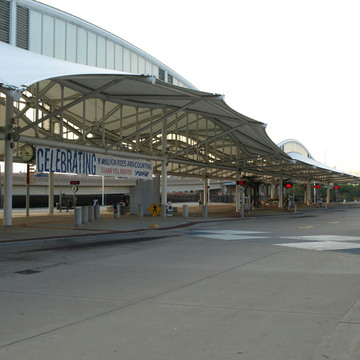You are here
Rapid Central Station (Rapid Central Station Transit Facility)
The Interurban Transit Partnership, also known as the Rapid, built this bus terminal in downtown Grand Rapids on a reclaimed brownfield site. A single, undulating, multilevel canopy of fiberglass fabric protects the waiting platform that fronts the station. The undulating roof suggests the rapids of the river, captures the rolling ribbon of the freeway, and celebrates bus travel. The roof is reminiscent of the Teflon-coated fiberglass roof of Denver International Airport that reflects the Rocky Mountains and Native American tipis.
Rapid Central Station is the first transit building in the country certified to meet LEED standards. The fifty-one-thousand-square-foot station integrates many environmentally friendly features. Recycled steel and concrete form the structure, bands of low emissivity glass admit natural light on both levels, and overhangs shade the interior from direct sunlight. A carpet of sedum that requires only minor irrigation and fertilization covers the roof. The sedum roof reduces heating and cooling costs and lessens runoff and pollution. Recycled glass aggregates form the terrazzo floors of the lobby.
The American Institute of Architects (AIA) Grand Valley Chapter stated, “The passenger waiting building fills in the context of existing buildings creating an urban edge which frames the undulating bus canopy. . . . A tough building type with a serious yet playful solution” ( Place, 2005 design awards). The Rapid Central Station Progressive AE (the Interurban Transit Partnership) received an AIA Michigan design award in 2005 and an Outstanding Public Transportation System award from the American Public Transportation Association in 2004.
Writing Credits
If SAH Archipedia has been useful to you, please consider supporting it.
SAH Archipedia tells the story of the United States through its buildings, landscapes, and cities. This freely available resource empowers the public with authoritative knowledge that deepens their understanding and appreciation of the built environment. But the Society of Architectural Historians, which created SAH Archipedia with University of Virginia Press, needs your support to maintain the high-caliber research, writing, photography, cartography, editing, design, and programming that make SAH Archipedia a trusted online resource available to all who value the history of place, heritage tourism, and learning.






